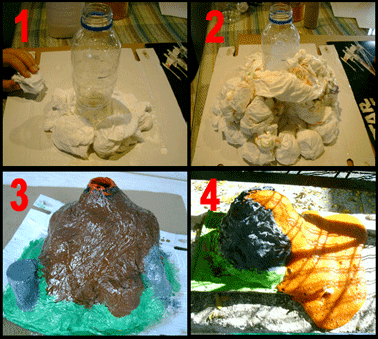 During our cultural week, the Science Department, headed by our teacher Rocío Fernández, has prepared a special activity: a homemade volcano with recycled materials, helping to the development of our Recapacicla Plan.
During our cultural week, the Science Department, headed by our teacher Rocío Fernández, has prepared a special activity: a homemade volcano with recycled materials, helping to the development of our Recapacicla Plan.Such activity has as main objectives:
- To know Nature phenomena.
- To make our students aware of the necessity for respecting our environment.
- To make students sensitive to the our worldwide environment and its problems.
Before creating the volcano we take the following aspects into account:

- A volcano made with paper mache or plaster. You can also use clay or if you're in a hurry to make your volcano, use a mound of dirt outside. Remember that we are going to reuse materials.
- A container that 33cl. or similar size container.(it can be a reuse plastic bottle)
- Red and yellow food coloring (optional)
- Vinegar
- Liquid dish washing soap

- Put the container into the volcano at the top
- Add two spoonfuls of baking soda
- Add about a spoonful of dish soap
- Add about 5 drops each of the red and yellow food coloring
Now for the eruption!: - Add about an ounce of the vinegar into the container and watch what your volcano come alive.


A VOLCANO is produced over thousands of years as heat a pressure build up. That aspect of a volcano is very difficult to recreate in a home experiment. However this volcano will give you an idea of what it might look like when a volcano erupts flowing lava. This is a classic experiment in which a CHEMICAL reaction can create the appearance of a PHYSICAL volcano eruption. You should look at pictures of volcanoes to be familiar with the different types. (A SHIELD volcano, for example is the most common kind of volcano, and yet few people know about them) The reaction will bubble up and flow down the side like a real volcano (only much faster!) Look for videos of volcanoes erupting and be sure that you understand how heat and pressure work to really make volcanoes erupt.

The project above is a DEMONSTRATION. To make it a true experiment, you can try to answer these questions:
1. Does vinegar temperature affect how fast the volcano erupts?
2. Does the shape of the volcano affect the direction the eruption travels?
3. What can be added to the "lava" to slow it down and make it more like real lava?
4. What combination of vinegar and baking soda creates the biggest eruption?
2. Does the shape of the volcano affect the direction the eruption travels?
3. What can be added to the "lava" to slow it down and make it more like real lava?
4. What combination of vinegar and baking soda creates the biggest eruption?

Here there are some pictures of our experiment:
If you want to know more, you can see the video below on Iceland Volcano Eruption by the National Geographic:
References:
http://www.cienciapopular.com/n/Ciencia/Volcanes/Volcanes.php
http://www.bbc.co.uk/cambridgeshire/science/2004/02/gallery/gallery1.shtml
http://www.sciencebob.com/experiments/volcano.php
-------------------------------------------------------------------------------------------------------------------------------------------------
Our students in 1ESO can connect what they have learnt after this experiment to their English graded reader Agathon: A Greek Slave in Pompeii which is based on the Vesuvious Volcano Eruption.
You can click on the following link to get more information about the Vesuvious Volcano or the book.
http://mercedesenglishclass1eso.blogspot.com.es/search/label/BOOKS%3A%20%20AGATHON


